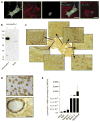Nodding syndrome may be an autoimmune reaction to the parasitic worm Onchocerca volvulus
- PMID: 28202777
- PMCID: PMC5434766
- DOI: 10.1126/scitranslmed.aaf6953
Nodding syndrome may be an autoimmune reaction to the parasitic worm Onchocerca volvulus
Abstract
Nodding syndrome is an epileptic disorder of unknown etiology that occurs in children in East Africa. There is an epidemiological association with Onchocerca volvulus, the parasitic worm that causes onchocerciasis (river blindness), but there is limited evidence that the parasite itself is neuroinvasive. We hypothesized that nodding syndrome may be an autoimmune-mediated disease. Using protein chip methodology, we detected autoantibodies to leiomodin-1 more abundantly in patients with nodding syndrome compared to unaffected controls from the same village. Leiomodin-1 autoantibodies were found in both the sera and cerebrospinal fluid of patients with nodding syndrome. Leiomodin-1 was found to be expressed in mature and developing human neurons in vitro and was localized in mouse brain to the CA3 region of the hippocampus, Purkinje cells in the cerebellum, and cortical neurons, structures that also appear to be affected in patients with nodding syndrome. Antibodies targeting leiomodin-1 were neurotoxic in vitro, and leiomodin-1 antibodies purified from patients with nodding syndrome were cross-reactive with O. volvulus antigens. This study provides initial evidence supporting the hypothesis that nodding syndrome is an autoimmune epileptic disorder caused by molecular mimicry with O. volvulus antigens and suggests that patients may benefit from immunomodulatory therapies.
Copyright © 2017, American Association for the Advancement of Science.
Conflict of interest statement
Figures




Comment in
-
Nodding syndrome: Preventable and treatable.Sci Transl Med. 2017 Feb 15;9(377):eaam8532. doi: 10.1126/scitranslmed.aam8532. Sci Transl Med. 2017. PMID: 28202778
-
Papers of note in Science Translational Medicine9 (377).Sci Signal. 2017 Feb 21;10(467):eaam9940. doi: 10.1126/scisignal.aam9940. Sci Signal. 2017. PMID: 28223418
-
Closing the Loop between Nodding Syndrome and Onchocerca Infection.Trends Parasitol. 2017 Jul;33(7):490. doi: 10.1016/j.pt.2017.05.002. Epub 2017 Jun 6. Trends Parasitol. 2017. PMID: 28596063 No abstract available.
-
River blindness goes beyond the eye: autoimmune antibodies, cross-reactive with Onchocerca volvulus antigen, detected in brain of patients with Nodding syndrome.Ann Transl Med. 2017 Dec;5(23):459. doi: 10.21037/atm.2017.08.35. Ann Transl Med. 2017. PMID: 29285492 Free PMC article. No abstract available.
-
New evidence for nodding disease as an autoimmune reaction to Onchocerca volvulus.Ann Transl Med. 2017 Dec;5(23):461. doi: 10.21037/atm.2017.09.06. Ann Transl Med. 2017. PMID: 29285494 Free PMC article. No abstract available.
-
Unravelling the mysterious onchocerciasis-nodding syndrome link: new developments and future challenges.Ann Transl Med. 2017 Dec;5(24):486. doi: 10.21037/atm.2017.09.36. Ann Transl Med. 2017. PMID: 29299448 Free PMC article. No abstract available.
-
Molecular Mimicry may Underlie a Worm-Associated Epilepsy Syndrome.Epilepsy Curr. 2018 May-Jun;18(3):180-181. doi: 10.5698/1535-7597.18.3.180. Epilepsy Curr. 2018. PMID: 29950943 Free PMC article. No abstract available.
References
-
- Sejvar JJ, Kakooza AM, Foltz JL, Makumbi I, Atai-Omoruto AD, Malimbo M, Ndyomugyenyi R, Alexander LN, Abang B, Downing RG, Ehrenberg A, Guilliams K, Helmers S, Melstrom P, Olara D, Perlman S, Ratto J, Trevathan E, Winkler AS, Dowell SF, Lwamafa D. Clinical, neurological, and electrophysiological features of nodding syndrome in Kitgum, Uganda: An observational case series. Lancet Neurol. 2013;12:166–174. - PubMed
-
- Idro R, Opoka RO, Aanyu HT, Kakooza-Mwesige A, Piloya-Were T, Namusoke H, Musoke SB, Nalugya J, Bangirana P, Mwaka AD, White S, Chong K, Atai-Omoruto AD, Mworozi E, Nankunda J, Kiguli S, Aceng JR, Tumwine JK. Nodding syndrome in Ugandan children—Clinical features, brain imaging and complications: A case series. BMJ Open. 2013;3 doi: 10.1136/bmjopen-2012-002540. - DOI - PMC - PubMed
-
- Winkler AS, Friedrich K, König R, Meindl M, Helbok R, Unterberger I, Gotwald T, Dharsee J, Velicheti S, Kidunda A, Jilek-Aall L, Matuja W, Schmutzhard E. The head nodding syndrome—Clinical classification and possible causes. Epilepsia. 2008;49:2008–2015. - PubMed
-
- Winkler AS, Friedrich K, Velicheti S, Dharsee J, König R, Nassri A, Meindl M, Kidunda A, Müller TH, Jilek-Aall L, Matuja W, Gotwald T, Schmutzhard E. MRI findings in people with epilepsy and nodding syndrome in an area endemic for onchocerciasis: An observational study. Afr Health Sci. 2013;13:529–540. - PMC - PubMed
Publication types
MeSH terms
Substances
Grants and funding
LinkOut - more resources
Full Text Sources
Other Literature Sources
Medical
Miscellaneous

